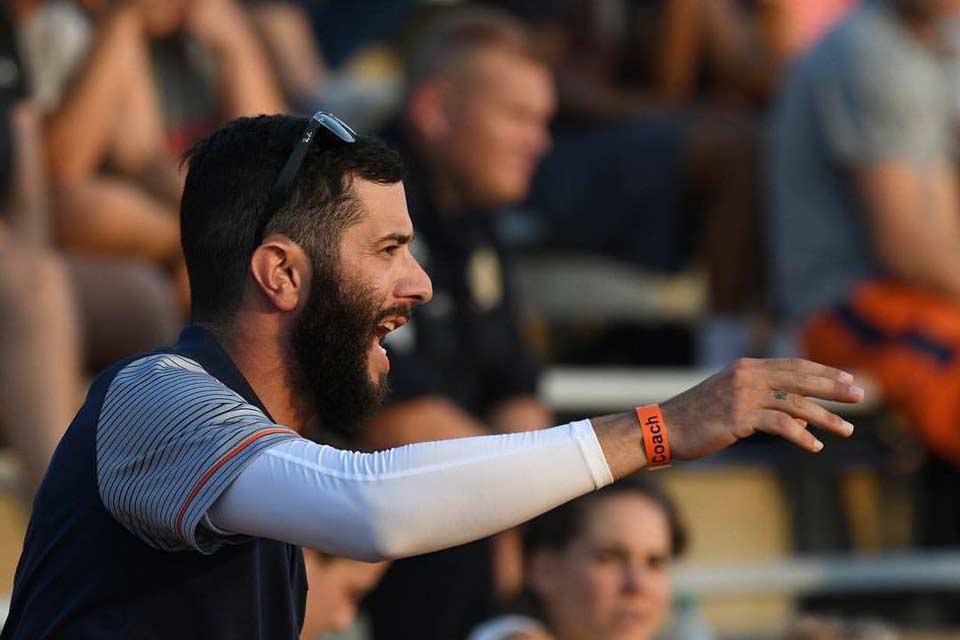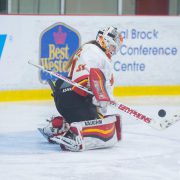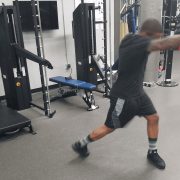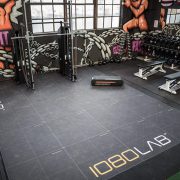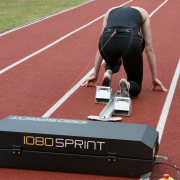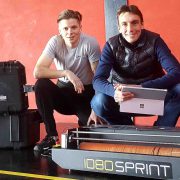“If you’ve got speed, you can figure out how to jump. It’s just not that complicated to me.” Power, velocity, and force, the connection is simple enough, and guided by Jumps and Combined Events Coach Jacob Cohen, athletes in the University of Illinois track program have been doing more than just figuring out how to jump—they’ve been soaring.
Cohen joined Head Coach Mike Turk’s program in 2017, after serving in a similar capacity at Louisiana Tech (during which time he guided standout long jumper Jarvis Gotch). Coach Turk himself had set a high bar in the program—before taking over the head coaching duties in 2010, he served as the Fighting Illini’s jumps coach, developing All-Americans in the long jump, high jump, and triple jump. Following in those footsteps, Cohen now includes under his charge 6-time All-American Jonathan Wells (high jump, long jump, heptathlon), as well as all of the men and women who jump: high jumpers, long jumpers, triple jumpers, pole vaulters, and multi-event athletes.
“It really doesn’t matter who lines up next to you, whether they’re a high jumper or a long jumper, you can all do the sprint training about the same way,” Cohen says, discussing how he manages training days with this diverse group. “The two biggest things I care about are acceleration ability and power output. Across event areas, if you can accelerate you can figure the rest out. To me, accelerative ability is one of the most important commodities that we train here. Power output for our group is also critical. When you go to a track meet and watch people jump or sprint, the person with the higher power output is going to succeed in most events.”
Phase 1: Preparation
To equip his athletes to take flight in a competition season that spans January through June, Cohen’s formal training plan begins in the summer. Early on it’s strength maintenance and lower volumes, taking into account the needs of 18-22 year-olds who may not be that thrilled about lifting four days a week in their off-season.
They hit the weight room to preserve their gains from the prior year. And, they run—fast.
“During the summer, we accelerate one-to-two times a week. I’m not a big believer in long running and things like that, I just think the faster you are the more likely you are to be successful,” Cohen says. “The great thing about acceleration in the weight room is you can build power there real quickly with a level amount of work. So that’s what we’re trying to do in the off-season.”
As an NSCA Certified Strength and Conditioning Specialist (CSCS), Cohen has more of a presence in the weight room than a typical events coach, and uses that knowledge-base to direct the focus toward complementary training methods and a strategic progression.
“As we build into the season more, I’m a big believer in hitting certain volume levels for our acceleration and our sprint workouts, as well as our plyometric volumes,” Cohen says. “When we get in season, the first thing we start to do when they come back in September is work towards those volume levels pretty quickly. And we accelerate on day one, every year. The bottom line for jumpers is that if you can accelerate down the runway, you’re probably going to be pretty successful.”
Phase 2: Acceleration
“We move pretty quickly and we stay in power development and acceleration development for the first eight weeks, where we don’t really touch on much more than 40-50 meter sprints at the most,” Cohen says. “At 40-50 meters you’re getting toward max velocity, and once we’re better at those qualities we start progressing toward some max speed work, which is also where the 1080 brings us some unique and very pleasant opportunities.”
A believer in potentiation (PAP) and contrast training, Cohen uses the program’s two 1080 Sprint systems to develop acceleration and power output through the prescribed pairing of resisted and free movements.
“Any time we can move from a loaded movement to an unloaded movement, especially with the longer contact patterns in the acceleration phase, having the 1080 and being able to contrast that to just being on the track, it helps the athletes feel that a little more surely,” Cohen says. “We’re really looking to set patterns right from the beginning of the year, where they understand positions, contact patterns, and rhythms—especially for jumpers. We start more in two point positions and work down towards the ground into blocks later in the year. Obviously, with them being jumpers, not all of them need to know how to come off out of the blocks, but I think it’s a good training tool. The bottom line is that coming out of the blocks helps develop power, just like anything else. That’s really how we set up the acceleration.”
Phase 3: Runway Speed
The mix of jumpers, pole vaulters, and multi-event athletes each have designated days in the week for their event-specific work, but when training the entire group for speed, Cohen keeps the repetitions low to emphasize quality. In the same regard, he tends to keep the resistance settings on the 1080 low as well, focusing on the athletes being able to rip off their resisted runs at speed and in rhythm—nothing about the training is meant to be slow and he hopes to prevent drop-offs in velocity from being more than 10%.
“We generally move toward a little more speed endurance once we get closer to the season, and when we’re in-season I like to do sprint-float-sprints and comparable workouts,” Cohen says. “All the work we’ve done up to that point really helps prime the work we’re going to do on the runway and the plyometric work we’re going to do, as well as everything down the road that’s a little more specific to the actual takeoff in jumping, and the mechanics of what they are going to do in their jumping events.”
Coaching a group of tech savvy athletes who understand how to identify power outputs and KPI’s on a variety of digital-based tools—both in the weight room and on the track—Cohen shares the data from the 1080 Sprint with his jumpers regarding everything from their past performances on resistance runs to how long it takes them to reach 90% of their max power output.
“Our athletes are very knowledgeable about the power outputs they’re looking to have and what we’re looking for in terms of watts per kilogram of bodyweight, so having the 1080 is huge because our athletes buy into the metrics,” Cohen says. “As we’re closer to season, we’ll rip off some runs of two-three-four kilograms (of resistance) again, and they’ll see the differences in how well they’re moving it and the undulations on the screen and how smooth their patterns are. It’s also really good for confidence—we time and measure almost everything we can around here. They believe in these metrics, and they have a sheet that tells them elite-level norms for event areas—so they know how to look at this information, and it breeds confidence.
“They’ll sit down on a voluntary workout day to watch video and we’ll pull up the 1080 web app and we’ll look at that as well,” Cohen continues. “All of the horizontal jumpers and the kids that sprint love the metrics because they know what it means. They know if they can accelerate 30 meters in a certain way and they’re building their speed and building their speed, they’re getting toward their 1.0 ten meter splits and things like that, and for guys under that, they know they’re going to run fast this year.”
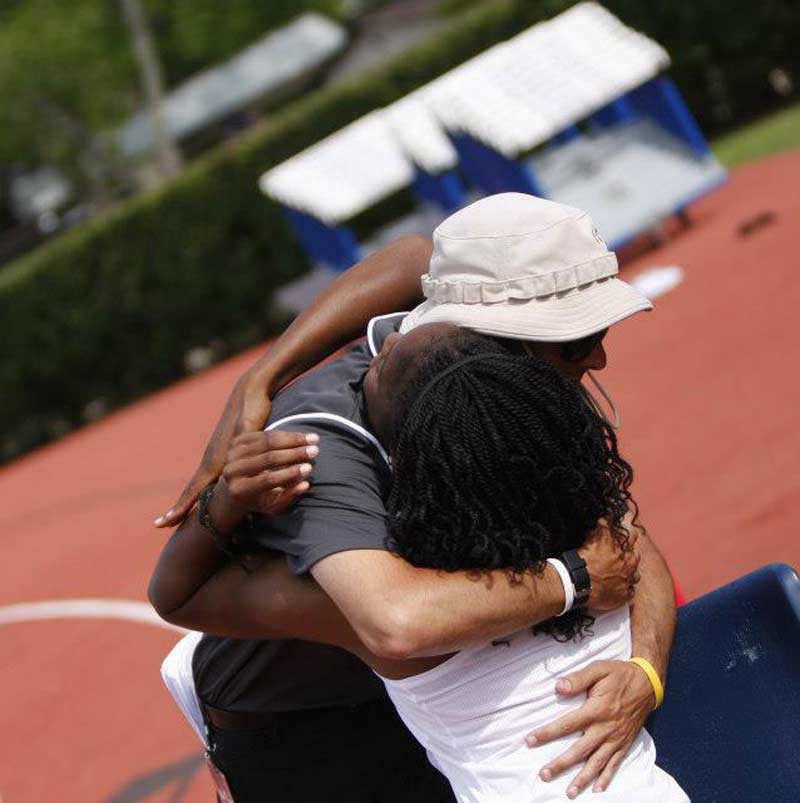
Coach Jacob Cohen celebrates training success with a former athlete.
Phase 4: Rhythm and Control
“This year, specifically we started with lighter resistance runs where we were looking more at two-to-three-to-four kilograms, so really not a ton (of resistance) on it,” Cohen says of his sessions using the 1080 Sprint. “I look at it as a way of stabilizing patterns—especially with jumpers, we’re constantly talking about rhythm because most of my horizontal jumpers are also sprinters. So, they understand the rhythm differences and how to manipulate their mechanics a little bit to match what they need to do.”
Rhythm and patterns are never far from Cohen’s mind, and with each phase and progression for his jumpers, he takes care to make sure they are stabilizing patterns and reinforcing postures. Once those patterns have been solidified, Cohen adjusts above the 2-4 kg resistance levels and works the force-velocity curve with higher resistance.
“By starting with lighter resistance we start to build that pattern without them feeling like they have to do anything extraordinary to (pull) it,” says Cohen. “Just applying a little bit of resistance in the beginning still gives them that ‘off-and-on’ feeling of the resisted and unresisted runs, and we build up from there, starting with runs of 10, 20, and 30 right off the bat to start the year. Depending on the distance, it gives them some different feels and helps them work their postures.”
With freshman in the program, there’s an adjustment period to sprinting with the cable-based resistance and gaining the confidence to apply the right amount of force in the first few steps of their drive phase. Cohen works more deliberately with the younger athletes, while progressing more rapidly with his more experienced jumpers.
“As we progress through the year, we generally do pick up the resistance a little bit after we feel like we’ve stabilized at 4 kg, where they’re not having any trouble with it and it’s not really changing much—their postures, their positions, their rhythms, their contact times are all good, then we’ll try to push it up,” Cohen says. “The same as we do in the weight room, where we start off with power development, we’ll start the year with 50% of our clean max or something like that, which is pretty light for them. But we’re working on making sure we’re explosive throughout the range of motion and our movement, so I look at the 1080 the same way where we can build and grow with it, adding power and force as we get deeper into our acceleration knowledge base and our ability levels.”
Phase 5: Liftoff
After emphasizing acceleration and power output through his training phases, in order to target explosiveness in the jump itself Cohen has employed creative methods to use the assistance mode of the 1080 Sprint in plyometric drills and progressions, particularly with his triple-jumpers.
“I have more developmental triple-jumpers here, but I think it’s a fantastic concept and the reason we use (assisted plyos) is because one of the factors that influences triple-jump is ground-contact times and being able to get through a certain range of motion,” Cohen says. “With some of our guys, we didn’t understand how to move through the ranges of motion with more speed and explosiveness.”
Among the sequences Cohen has programmed with assistance are five-bounds, double-doubles doing a standing long jump into a left-left right-right, as well as left-left-left-right, moving through a full range of motion but using light assistance to allow his jumpers to feel the contact times striking just a little more quickly.
“To me, it’s same idea as when we do overspeed and assisted running—where we can almost over-stimulate the nervous system and push them out of their comfort zones. So, if their triple-jump phases average 15 feet, how can we teach them to feel what it’s going to feel like time-wise and rhythm-wise to go 17 feet?”
Cohen has also worked directly on the runway, setting up the 1080 Sprint 10 meters behind the pit and programming the system like an assisted run, using the front hook of the belt to tow jumpers into their approach with the cable release timed at the front of the sand so they could land freely and cleanly.
“We’ve had some fun with the plyometrics and the bounding. One-to-two kilograms of resistance or assistance is not a ton, but it’s enough to get your metrics,” Cohen says. “And we use it on a year to year basis, so we’ll go back next year and we’ll do the same thing at the same time, so we can compare. Then the athletes will know how they’ve gotten better and they can see some cool stuff with that as well.”
